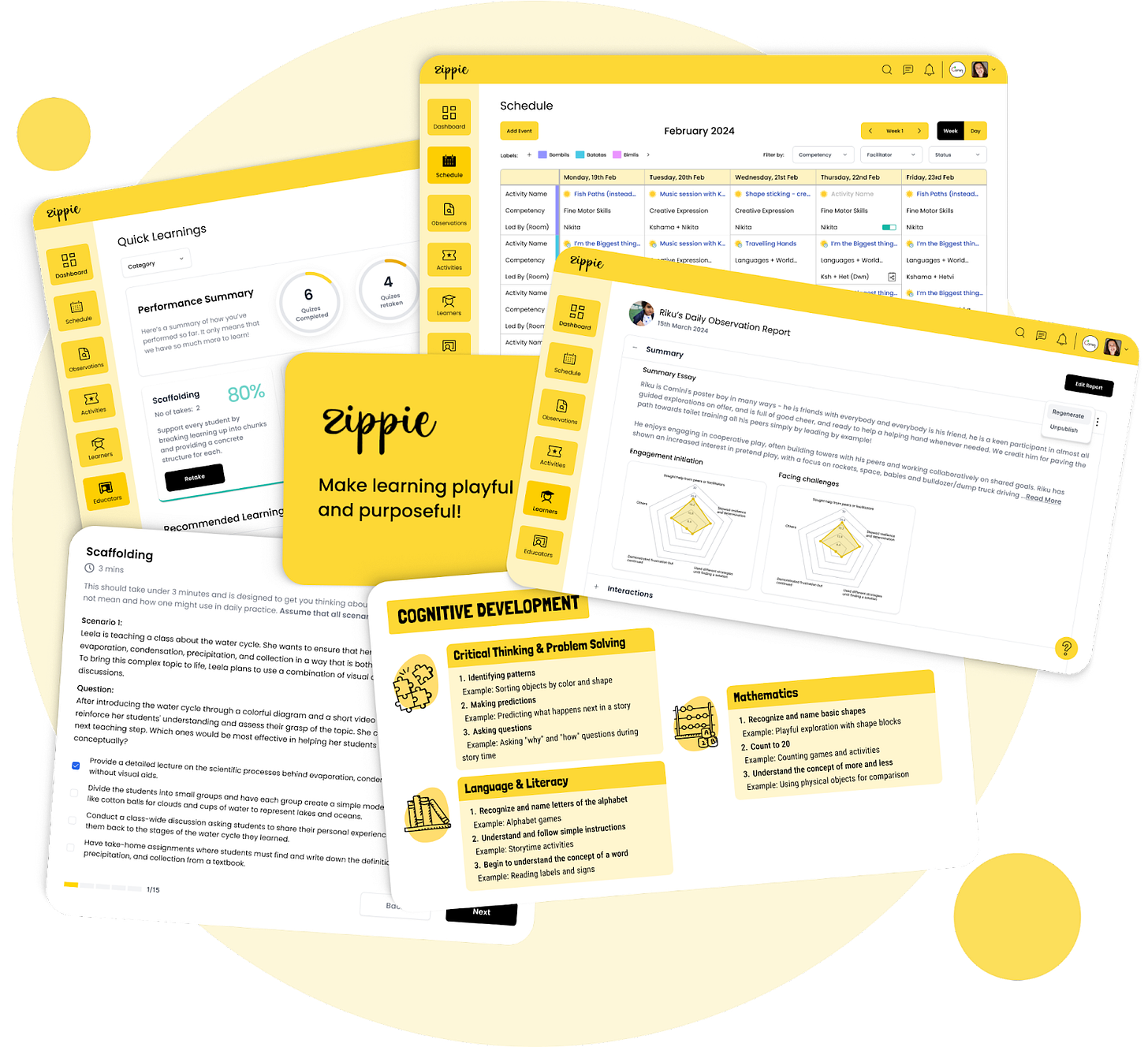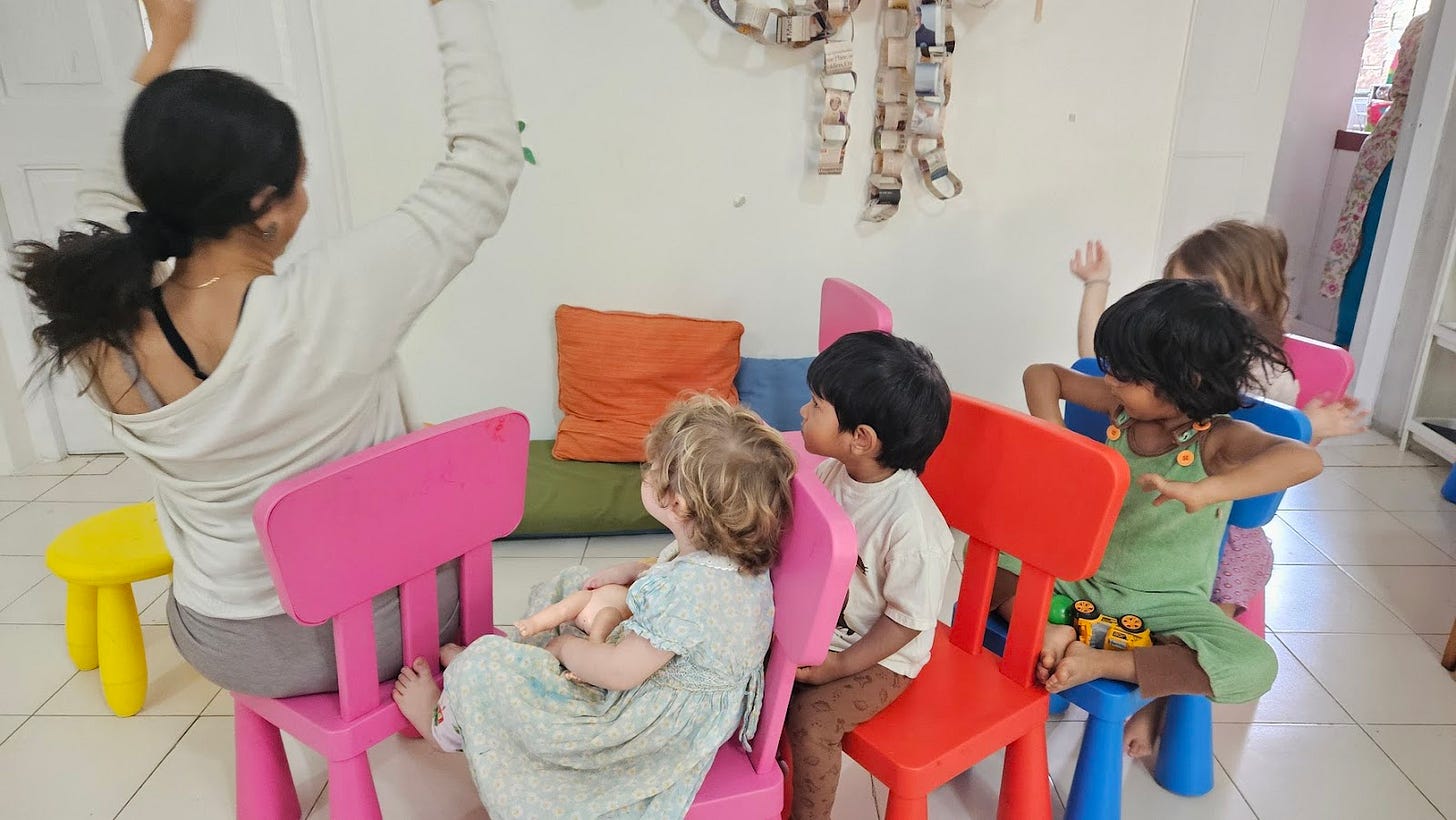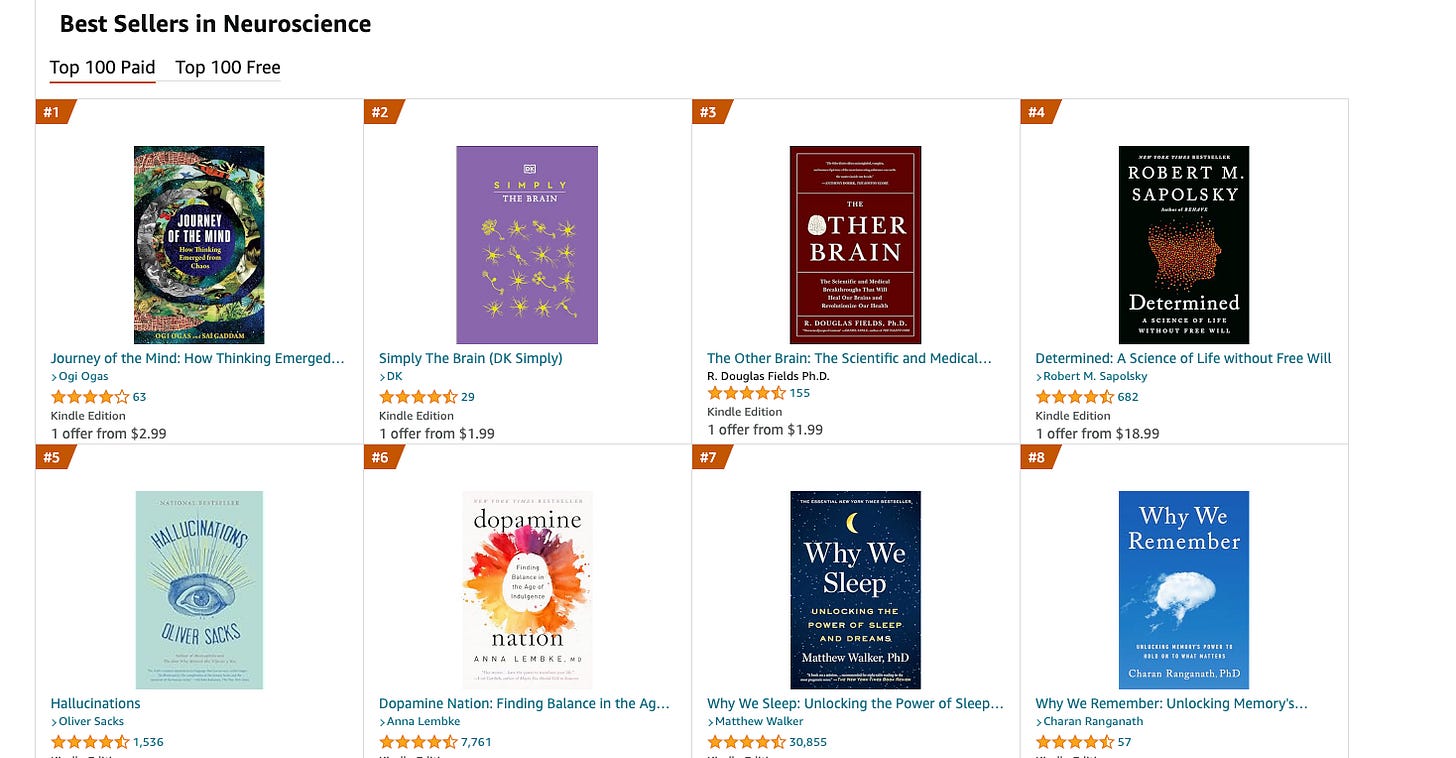What Does an AI-Powered School Look Like?
This is a slice of life from Comini, our microschool. What does it look like, practically, when we talk about bringing AI into the classroom alongside teachers? Well, for one thing, the AI is invisible. No dystopian humanoid robots share desks with children, and the space isn't fitted out with the latest technology and gadgets. There are also no sensors, hidden microphones, and cameras lurking in corners, watching every move.
The common techno-utopian fantasy these days is to have AI chatbots aid or even replace teachers. Not here.
In our setting, teachers are celebrated, and they are there to do what they do best. Only, they are assisted in such a way that they can do what they do far better than they ever could before. We have written about how AI can help great teachers scale. This is how it works in practice.
AI makes them superhuman.
A reading activity is in full swing, and all the other kids are heroically stumbling their way through letters and syllables while the teacher makes her way from one child to another. Meera looks down at the jumble of squiggles in her book and sighs. She stares out the window. Down below in the street, she watches a stray dog sniffing around. She wishes she could bathe him, feed him, give him a name, and love him. Her facilitator comes around and gently redirects her to the book. Meera doesn’t want to read. What’s the point anyway—when she could be out there?
If we’re going to have any sort of meaningful discussion about the role of AI in the classroom, we have to step back and examine the role of a teacher in depth. What does a really great teacher do?
Our traditional idea of what makes a great teacher is all about knowledge transfer. A good teacher takes knowledge and makes their pupils absorb and understand it, right? Well, yes… this is true, but saying this is a teacher’s job, is as limiting as saying your house’s job is to give you a place to put your clothes. If transferring and explaining knowledge was all they did, why haven’t we gotten rid of teachers long ago and replaced them with textbooks and prerecorded video lessons? (I guess some are trying to do just that!)

A great teacher’s job is complex and intensely human. They connect with children. They connect with parents. They flex and plan along the curriculum and adapt, and during lessons, they pause and emphasize and empathize.
And, there is something more, something unspoken, that a great teacher transfers to their students, and you would have sensed this when you were at school. A great teacher, the best kind of teacher, transfers more than knowledge. They transfer passion, interest, excitement, and curiosity. They care. And all of these are critical ingredients to learning. When these intangible qualities are missing, you can get the kindling and the firewood ready, but the fire of learning will not burn. The teacher is the one who provides the spark.
You see, culture chews up curriculum before breakfast. You could teach a child what you want them to learn from dawn till dusk, but if they do not see this as a valuable topic or subject and they are not motivated by the people and culture around them to explore this, you’re wasting your breath. As humans, we are fundamentally wired to seek out each other, talk to each other, learn from each other. A child won’t appreciate the beauty in 19th-century impressionism because a chatbot or retrofitted Roomba can rattle out 25 points about why the art is lovely. They learn to appreciate it because someone they love, cares, admires it, and talks passionately about it.
It’s easy to see how a teacher facilitates a large part of this learning culture. They model the world and help children navigate different learning paths. And they help children to ask and understand why that path.
A teacher has their hands full with connecting with children - observing them, leading them, facilitating experiences that they can explore and where they can grow. And they need to observe and personalize the learning journeys of multliple children - so a lot of what they do happens after and before they actually teach. This is no easy feat, and so even the world’s greatest teachers could use a little help.
Meera’s facilitator at the microschool picks up on the fact that she’s not engaged in learning to read like her peers. It’s a puzzling situation, because Meera is excelling in general and participates eagerly during most activities. Her teacher calls in the parents, and they are more than a little concerned and anxious. Meera is falling behind, with children younger than her reading fluently already. They don’t believe in rushing the process, but it’s natural to start getting worried. The teacher says that her gut is telling her that Meera is not motivated to read. They try figuring out what it would look like to motivate Meera, but they’re coming up blank - it’s not like they haven’t tried this before.
The teacher turns to Zippie, her AI assistant. She’s been feeding it with data and observations for her individual students for the past month and she hopes that maybe it would pick up a trend in Meera’s interests that she might be missing and give them an age-appropriate list of reading recommendations.
Zippie has an answer ready. It mentions that Meera loves animals, and that she has a strong sense of justice and likes fixing problems when interacting with her peers. She also loves whimsy. And, she loves the show Mira, Royal Detective. Zippie suggests the series “Dog Man” by Dav Pilkey. Her parents are not surprised by Meera’s interests and Zippie’s observations about their daughter. They know her very well, after all. But the Dog Man books would have never occurred to them as a choice of reading material for Meera.
Would it work? It was worth a shot.
And that is how AI helps teachers. It plays to its strengths: it observes, remembers observations, analyzes, and recommends plans.
AI can:
Write summarized, narrative observations of each child based on the teacher’s observations
Give the teacher a GPS for the learning landscape of each child
Craft exploration guides (work) at the right level
Create planning calendars, tailoring curriculum requirements to the children’s existing interests
Come up with creative challenges at the right difficulty level for students so they can explore learning paths and build fluency. See one of our (fabulous) AI-assisted assignments.
Train teachers in applied, hands-on ways that go beyond theoretical knowledge. For example, see this exercise to help teach teachers about scaffolding and help them anchor their learning in practical scenarios.
To teach effectively, teachers must know where each child is. This is virtually impossible, especially in the large classrooms of a traditional school. Even in a microschool, keeping track of where each child is, along with their ever-unfolding interests, and analyzing that into a cohesive whole, is a challenging (and time-consuming) task.
When AI steps in, teachers can focus on observing children – on really observing them without any preconceived notions (and it can help with that too). These observations over time are analyzed and summarized and connected together in a way no human is able to, because these are the kinds of things that current AI excels at: summarizing, recasting into a different perspective, and creating something using a paint-by-numbers approach.
Teachers can then use their human intuition and interpersonal skills to decide what to use (and what not to) and apply all of the information in a way that works for each child.
The way we use AI at Comini, and the way we think is the right way forward, is not about turning teachers into chatbot handlers and replacing the most important parts of their job. It’s exactly the opposite. When used well, teachers can reduce the time they spend on many of the routine tasks they normally need to do, and they can focus on really teaching: caring, loving, promoting grit and resilience, and transferring passion, curiosity, and excitement, which are absorbed by the kids as the teacher lives this out.
Meera’s teacher could not believe her eyes. She’d dismissed her class after reading to go outside for some free play time… and here Meera was, curled up in the corner with Dog Man. It has only been a week now since they gave her the book, but Meera is suddenly reading.
With a mere month’s worth of data captured, Meera’s teacher starts getting very excited indeed about the possibilites her new AI helper offers. What about Kabir, who was thriving at Math, until he got inexplicably stuck two weeks ago? Or maybe there would be some insights for little Ellie, who needs to find something she excels at to unlock her confidence. And… could it help her plan out curriculum tasks on the calendar? She hated doing that - was it smart enough for this?
The rate of AI adoption has been incredible in all spheres of life. And it won’t be any different for education. We are betting that ten years from now, talking about AI-powered schools will sound as silly as talking about electricity-powered schools. It is going to be ubiquitous, cheap, transformative, and universally taken for granted—like using a calculator. Or a GPS, which is probably a better metaphor for it.
Are you excited about this brave new world?
Fortunately, this isn’t some pie-in-the-sky article about theoretical things AI could do one day.
If you’re looking forward to the possibilities of what AI can do in the classroom, we’ve got programs, ideas, and tools in place.
If you are curious to learn how you could start using AI in the classroom, or you want to learn more about how you can personalize learning at your microschool (or homeschool), please reach out to us.
We are also looking for more teachers to turn them into superheroes. If you are interested in teaching in a whole new way and making a difference while having fun with kids every single day, please reach out to us here!
Using AI well in learning requires us to understand learning well. Sai (our co-founder) has written a book about it. And it happened to be trending at #1 on Amazon (neuroscience) recently. Go get it!






What a fascinating way of thinking through AI in schools. Thank you for sharing.